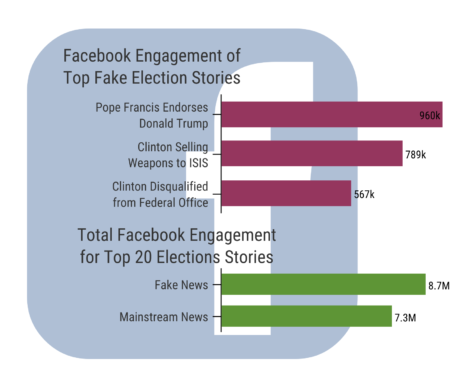Fake News and its prevalence during the 2016 Presidential Election
The Urban Legend’s morning headline reads, “Fare leaves Urban after multiple students are hospitalized from food poisoning.” You pause. What? How can you tell if this is true or not?
Fake news describes articles uploaded to the internet with such a bias that they state false information. Take, for instance, this headline from WTOE 5 News in July 2016: “Pope Francis Shocks The World, Endorses Donald Trump.” This was the most shared article during the election season, according to a Buzzfeed investigation about Facebook’s fake news. However, it’s completely made up. A Stanford study, released in November of 2016, found that only a quarter of students recognize the blue verification checkmark on Facebook accounts, and when asked to choose which source was more reliable, Fox News or a fake news account posing as Fox News, over 30 percent thought the fake account was more trustworthy due to the “fun graphics.”
Facebook is a key site for interaction with fake news articles. The site has 1.8 billion active users who sign in every month. Instead of getting their news from solely news-focused companies, Nick Wingfield of New York Times said, “nearly half of American adults rely on Facebook as a news source.”
The Pew Research Center found that “About six-in-ten Web-using Millennials (61 percent) reported getting political news on Facebook.” Facebook, which co-founder Mark Zuckerberg describes as merely a “technology company,” streamlines the way American citizens consume and share news. However, during the 2016 Presidential election, fake news articles about the election were getting more clicks than any other news, which was partially due to a very important algorithm.
When Facebook first started their News Feed, the algorithm was merely chronological; a user saw what had been posted most recently. In 2009, the algorithm was changed to show more popular posts first. Eight years later, after studying the algorithm intensely, Will Oremus of Slate, a top media website, has determined the following: the news feed algorithm looks at the past articles the user has clicked on, liked, shared, and commented on, while also taking into account what posts one’s friends interact with. News Feed then displays posts based on this history of interaction with past media. Everything the client does is recorded and used by the algorithm. The algorithm predicts what the consumer is most likely to click on, and ranks the thousands of posts they could be receiving by how likely the client is to click. Amanda Taub of New York Times argues that his leads to a partisan bias, as the echo chamber of news simply shows the consumer what they are sure to enjoy. Zuckerberg said, “The problem is that people don’t click on things that don’t conform to their worldview. I don’t know what to do about that.” Due to the algorithm Trump supporters would see articles that were pro-Trump or anti-Hillary, while the opposite occurred for Hillary voters.
Per The New York Times, about 120 million American adults relied on Facebook as their primary news source during voting season when fake news was more prevalent than factual news. As the presidential nominees debated bitterly, Buzzfeed news chief said, “about three months before the election, that critical time, we actually saw fake news spike. And we saw the mainstream news engagement on Facebook for [the] top [legitimate] 20 stories decline.” This got even worse, as Howard Kutz from Fox News said, “In the weeks leading up to the election, verified news drew 7,367,000 shares, reactions and comments, while the fictional material drew 8,711,000 shares, reactions and comments.” These fake news articles happened to lean toward one side in particular. Craig Silverman, Buzzfeed’s founding editor, said, “Of the 20 top-performing false election stories identified in the analysis, all but three were overtly pro-Donald Trump or anti-Hillary Clinton.”
The “hyperpartisan” nature of both parties leads to a constant spread of illegitimate news. Amanda Taub, of the New York Times, said recent studies have shown that, “Partisan bias strongly influences whom people perceive as trustworthy.”
One fake news purveyor, Paul Horner, went as far as to say that “Nobody fact-checks anything anymore — I mean, that’s how Trump got elected … My sites were picked up by Trump supporters all the time. I think Trump is in the White House because of me. His followers don’t fact-check anything — they’ll post everything, believe anything.”
As Facebook tries to change its algorithms and function as an arbiter of content, James McCarthy, a media expert from themediaonline.com, urges us all to remember that Facebook isn’t a publisher, but rather “a distribution company.”
Clarke Weatherspoon, Dean of Equity and Inclusion at Urban, said, “With regard to social media, fake news is a real problem and has been for many years.” He believes that as this problem persists, consumers need to “have patience with new source(s), read widely, think critically and question every source.”












